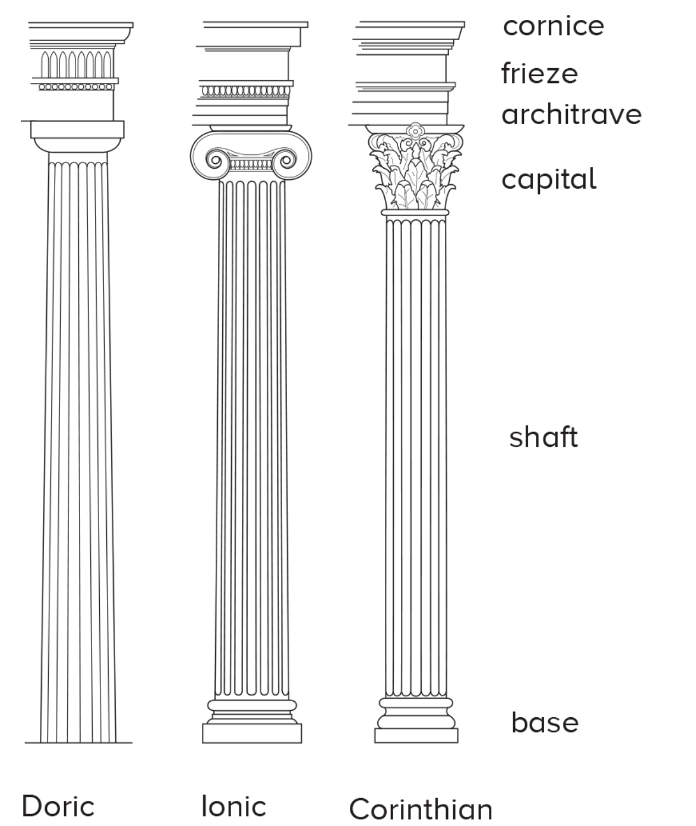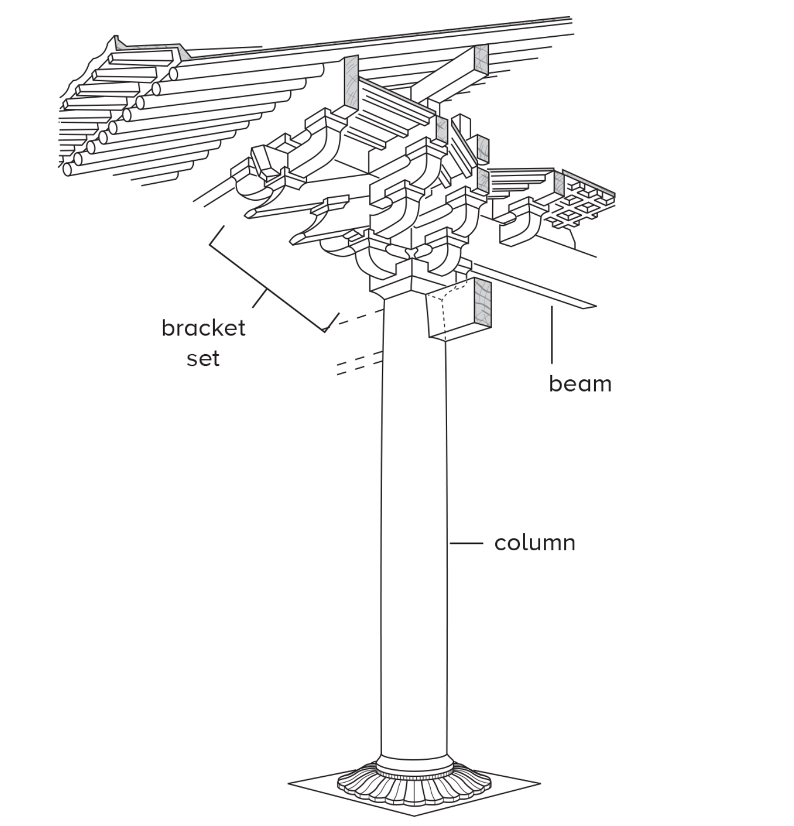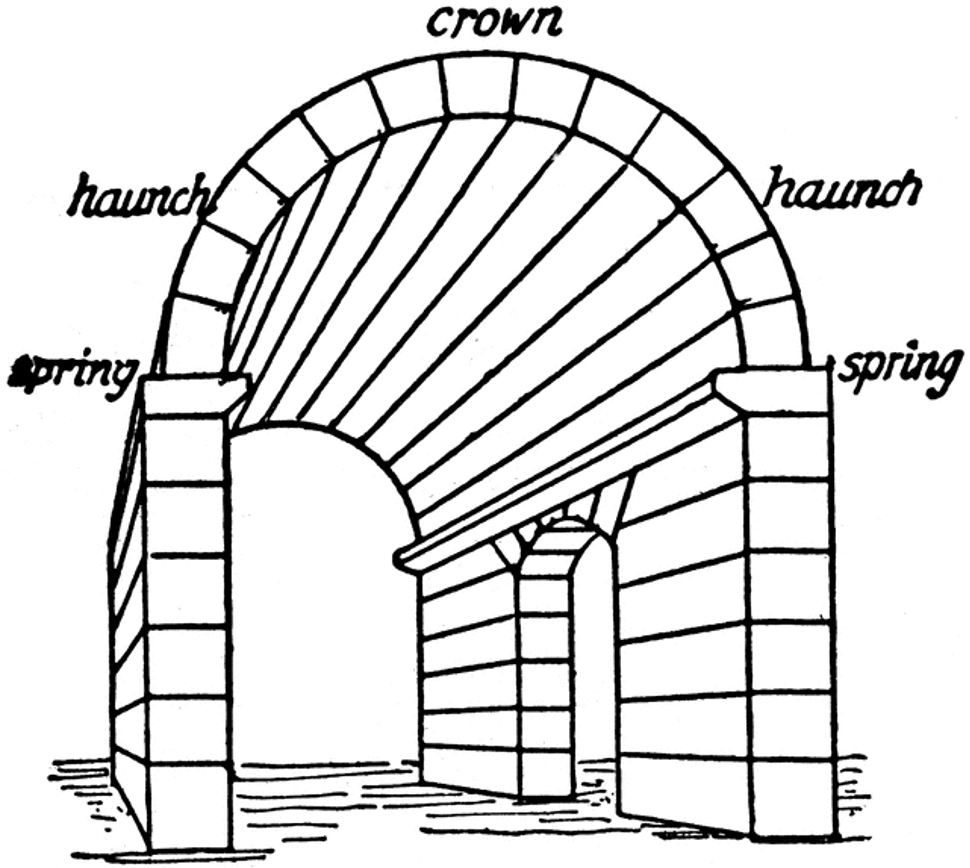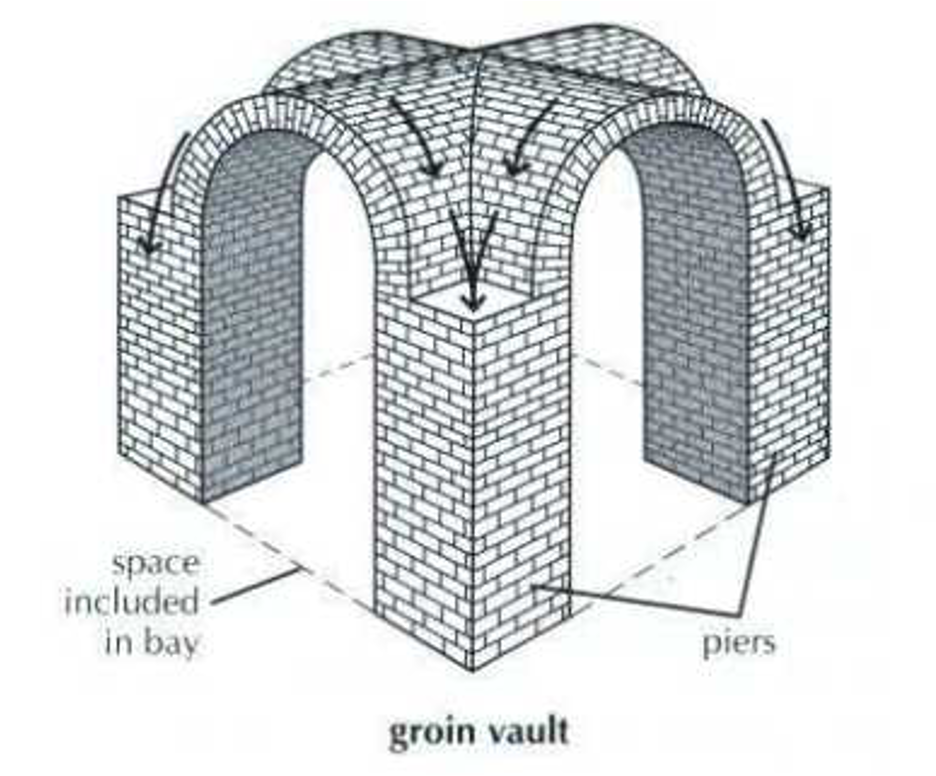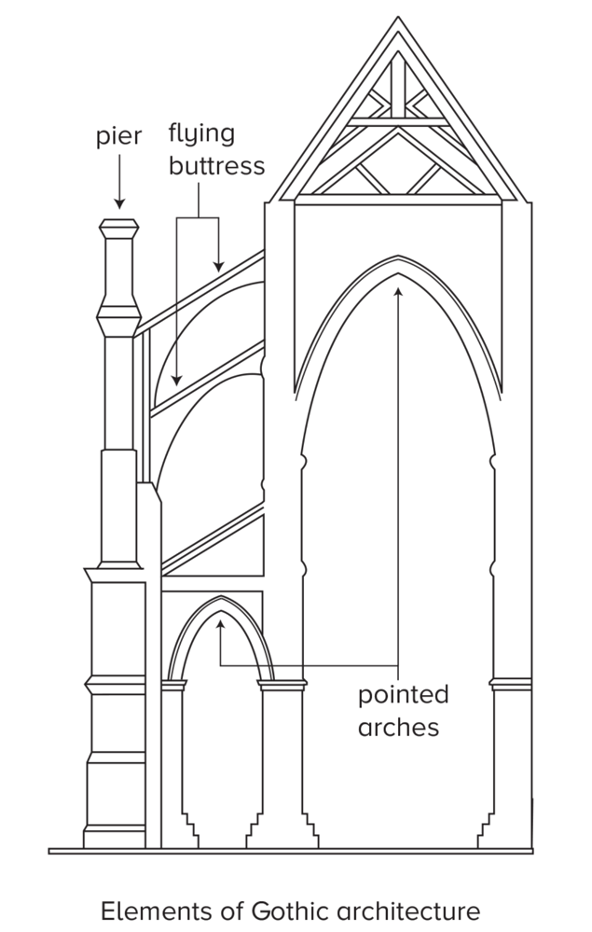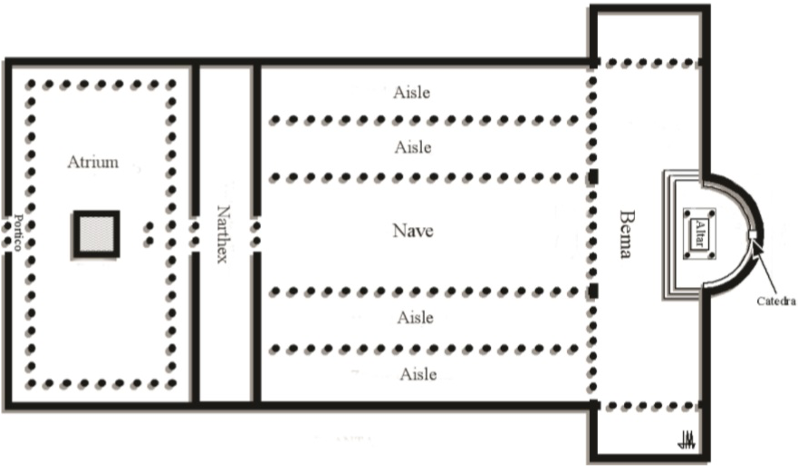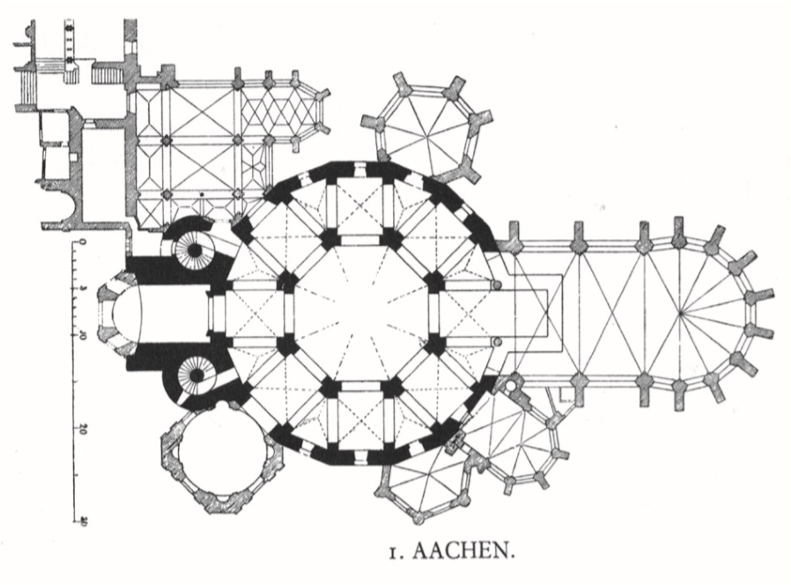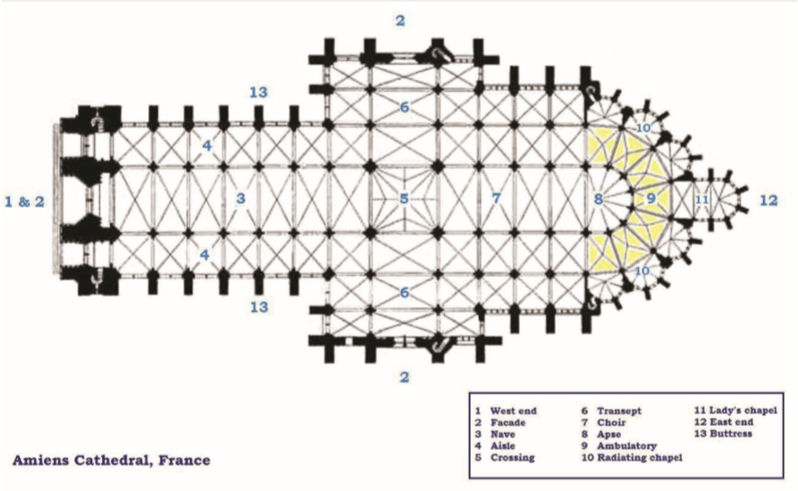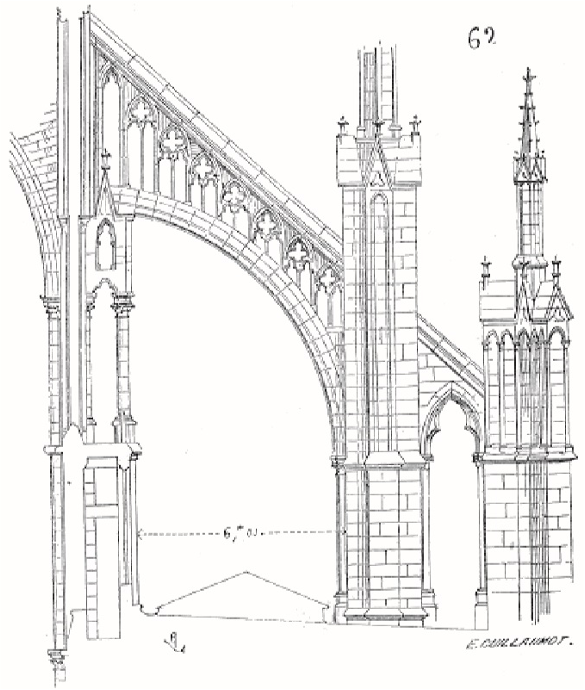- Chapter 7: Form in Architecture
- Learning Outcomes
- Post-and-Lintel
- Greek Orders
- Asian Bracket Sets
- Arch
- Barrel Vault
- Groin Vaults
- Pointed Arch and Vault
- Piers and Flying Buttresses
- Dome
- Residential Functions
- Communal Living Center using Stone
- Residential Palace of Minoan Civilization
- Residential Palace of Mesopotamian Empire
- Lamassu from the citadel of Sargon II
- Urban Dwellings
- Private Homes
- Royal Palaces
- Residential Structures for the Wealthy
- Prairie Style
- Community and Government
- Roman Forum and Basilica
- Theaters and Amphitheaters
- Concrete
- Commerce
- Steel Frame Construction
- Worship
- Temple of Horus, Edfu
- Inside the Edfu Temple
- Temple of Hephaestus, Athens
- The Acropolis of Athens, Greece
- Brihadeshwara Temple, India
- Sanchi Stupa, Madhya Pradesh
- Sultan Ahmed Mosque, Istanbul, Turkey
- Diagram of old St. Peter’s Basilica
- Floorplan of Aachen Chapel, 1887-1901
- Floorplan of Amiens Cathedral
- Diagram of flying buttress of the Cathedral of Our Lady of Amiens
- Martyrs, Chartres Cathedral
- Royal Portal of Chartres Cathedral
- E. Fay Jones, Thorncrown Chapel, 1980.
- Presentation
- Lecture Video
- Quiz
Chapter 7: Form in Architecture
Learning Outcomes
After reading this chapter, you should be able to:
- Describe the differences between function and form in architecture
- Discuss how form and function work together in architecture created for different purposes
- State different types and uses of architecture
Post-and-Lintel
- Post-and-Lintel: two upright beams supporting a horizontal beam to create a rectangular opening
Architecture satisfies a basic, universal human need for a roof over one’s head. More than walls, more than a chair to sit on or a soft bed to lie on, a roof is the classic symbol of protection and security. More than any of the other arts, architecture demands structural stability. Post-and-lintel construction is the most elementary structural method, based on two uprights (the posts) supporting a horizontal crosspiece (the lintel, or beam; see diagram). This configuration can be continued indefinitely, so that there may be one very long horizontal supported at critical points along the way by vertical posts to carry its weight to the ground. The posts are in compression; the lintel is in compression on its upper side and tension on its lower side. The most common materials for post-and-lintel construction are stone and wood. Post-and-lintel construction has been, for at least four thousand years, a favorite method of architects for raising a roof and providing open space underneath. On a smaller scale, it is used to open up windows and doorways in load-bearing construction, the lintel bearing the weight of the material above and protecting the void below.
Temple of Luxor
- Hypostyle Hall – a large hall created with post-and-lintel construction
The ruins of a portion of the ancient Egyptian temple of Luxor illustrate the majesty and also the limits of post-and-lintel construction in stone. Carved as bundles of stems capped by stylized papyrus-flower buds, the stone columns support rows of heavy stone lintels, with each lintel spanning two columns. The lintels would in turn have supported slabs of stone that served as both ceiling and roof. Because stone does not have great tensile strength, the supporting columns must be closely spaced. A large hall erected in post-and-lintel construction was thus a virtual forest of columns inside. We call such spaces hypostyle halls, from the Greek for “beneath columns.” Ancient Egyptians associated hypostyle halls with the primal swamp of creation, where, according to Egyptian belief, the first mound of dry land arose at the dawn of the world. To make that connection clear, they designed their columns as stylized versions of plants that grew in the marshes of the Nile. Surrounded by load-bearing walls pierced high up by small windows, the hypostyle halls of Egyptian temples were dark and mysterious places.
Greek Orders
- Doric – no base with plain stone slab above rounded stone at capital
- Ionic – stepped base with carved capital with two graceful spirals called volutes
- Corinthian – detailed base and capital carved with acanthus leaves
In ancient Greece, the design of post-and-lintel buildings, especially temples, became standardized in certain features. Greek architects developed and codified three major architectural styles, roughly in sequence. We know them as the Greek orders. The most distinctive feature of each was the design of the column. By the 7th century B.C.E., the Doric style had been introduced. A Doric column has no base, nothing separating it from the floor below; its capital, the topmost part between the shaft of the column and the roof or lintel, is a plain stone slab above a rounded stone. The Ionic style was developed in the 6th century B.C.E. and gradually replaced the Doric. An Ionic column has a stepped base and a carved capital in the form of two graceful spirals known as volutes. The Corinthian style, which appeared in the 4th century B.C.E., is yet more elaborate, having a more detailed base and a capital carved as a stylized bouquet of acanthus leaves. The most famous and influential work of Greek architecture is certainly the Parthenon, a Doric temple
Asian Bracket Sets
- Bracket Sets – interlocking wooden brackets and arms that crown the columns
Post-and-lintel architecture developed in China and adopted by Japan is shown in the Buddhist shrines. Our first impression they seem like weighty and elaborate superstructure of gracefully curved roofs resting—lightly, somehow—on slender wooden columns. The effect is miraculous, for the building seems to float; but how can all of that weight rest on such slender supports? The answer lies in the cluster of interlocking wooden brackets and arms that crowns each column. Called bracket sets, they distribute the weight of the roof and its large, overhanging eaves evenly onto the wooden columns, allowing each column to bear up to five times the weight it could support directly. Chinese and Japanese architects developed many variations on the bracket set over the centuries, making them larger or smaller, more elaborate or simpler, more prominent or more subtle.
Arch
- Arch: a curved or pointed structure spanning an opening and supporting the weight above.
- Voussoir – wedge-shaped blocks of stone
- Keystone – topmost block of the arch
Although the round arch was used by the ancient peoples of Mesopotamia several centuries before our common era, it was most fully developed by the Romans, who perfected the form in the 2nd century B.C.E. The arch is a compressive structure. Its components push against one another to achieve stability. This makes it particularly suited to stone, which has high compressive strength. An arch is not stable until it is complete, however. During construction, it must be supported from below by a temporary wooden framework called a centering. Once the centering is in place, wedge-shaped blocks of stone (called voussoir – voo-swares) are set along its arch-shaped top, beginning at both ends simultaneously. When the topmost block, called the keystone, is wedged into place, the two sides of the arch meet and lean against each other. The centering can be removed, for the arch is now self-supporting. An arch exerts an outward thrust at its base. If an arch starts above the ground it has an impost – or springing line from which the arch rises. The arch has many virtues. In addition to being an attractive form, it enables the architect to open fairly large spaces in a wall without risking the building’s structural soundness. These spaces admit light, reduce the weight of the walls, and decrease the amount of material needed.
Pont du Gard at Nîmes, France
- Arcades – rows of arches set on columns
- Aqueduct – structure for transporting water
Among the most elegant and enduring of Roman structures based on the arch is the Pont du Gard at Nîmes, France, built in about 15 C.E., when the empire was nearing its farthest expansion. The Pont du Gard consists of three tiers of arcades—rows of arches set on columns or, as here, massive piers. It functioned as an aqueduct, a structure for transporting water, and its lower level served as a footbridge across the river. That it stands today virtually intact after two thousand years (and is crossed by cyclists on the route of the famous Tour de France bicycle race) testifies to the Romans’ brilliant engineering skill. Visually, the Pont du Gard exemplifies the best qualities of arch construction. Solid and heavy, obviously durable, it is shot through with open spaces that make it seem light and its weight-bearing capabilities effortless.
Barrel Vault
- Barrel Vault: a series of circular arches that form a ceiling or roof.
When the arch is extended in depth—when it is, in reality, many arches placed flush one behind the other—the result is called a barrel vault. This vault construction makes it possible to create large interior spaces. The Romans made great use of the barrel vault, but for its finest expression we look many hundreds of years later, to the churches of the Middle Ages.
Abbey Church of Sainte-Foy
The abbey church of Sainte-Foy, in the French city of Conques, is an example of the style that was prevalent throughout western Europe from about 900 to 1200—a style known as Romanesque. Earlier churches had used the Roman round arch to span the spaces between interior columns that ultimately held up the roof. There were no ceilings, however. Rather, worshipers looked up into a system of wooden trusses and the underside of a pitched roof. Imagine looking directly up into the attic of a house and you will get the idea. With the Romanesque style, builders set a stone barrel vault as a ceiling over the nave (the long central area), hiding the roof structure from view. The barrel vault unified the interior visually, providing a soaring, majestic climax to the rhythms announced by the arches below. On the side aisles of Sainte-Foy (not visible in the photograph), the builders employed a series of groin vaults. A groin vault results when two barrel vaults are crossed at right angles to each other, thus directing the weights and stresses down into the four corners. By dividing a space into rectangular segments known as bays, each of which contains one groin vault, the architects could cover a long span safely and economically. The repetition of bays also creates a satisfying rhythmic pattern.
Groin Vaults
- Groin Vaults: two Barrel Vaults that intersect at 90 degrees
A groin vault results when two barrel vaults are crossed at right angles to each other, thus directing the weights and stresses down into the four corners. Although the round arch and the vault of the Romanesque era solved many problems and made many things possible, they nevertheless had certain drawbacks. For one thing, a round arch, to be stable, must be a semicircle; therefore, the height of the arch is limited by its width. Two other difficulties were weight and darkness. Barrel vaults are both literally and visually heavy, calling for huge masses of stone to maintain their structural stability. They exert an outward thrust all along their base, which builders countered by setting them in massive walls that they dared not weaken with light-admitting openings.
Pointed Arch and Vault
- Ribs - In architecture, a projecting band on a ceiling or a vault.
The Gothic period in Europe, which followed the Romanesque, solved those problems with the pointed arch. The pointed arch, although seemingly not very different from the round one, offers two advantages. Because the sides arc up to a point, weight is channeled down to the ground at a steeper angle, and therefore the arch can be taller. The vault constructed from such an arch also can be much taller than a barrel vault. In addition, a pointed arch exerts far less outward thrust at its base than does a round arch. Architects of the Gothic period found they did not need heavy masses of material throughout the curve of the vault, as long as the major points of intersection were reinforced. These reinforcements, called ribs, are visible in the nave ceiling of Reims Cathedral
Piers and Flying Buttresses
Gothic builders reinforced their walls from the outside with buttresses, piers, and a new invention, flying buttresses. The principles are easy to understand if you imagine yourself using your own weight to prop up a wall. If you stand next to a wall and press the entire length of your body against it, you are a buttress. If you stand away from the wall and press against it with outstretched arms, your body is a pier, and your arms are flying buttresses. The illustration here of the exterior of Reims Cathedral shows the Gothic system of buttresses, piers, and flying buttresses, as well as the numerous windows that made them necessary.
Reims Cathedral, France
- Stained glass is colored glass used to form decorative or pictorial designs, notably for church windows, both by painting and especially by setting contrasting pieces in a lead framework like a mosaic.
Gothic architecture also used the addition of stained glass to add light into the buildings. A rose window is a circular stained-glass window dedicated to the Virgin Mary, usually found above the main portals of Gothic churches.
Dome
- Dome: a spherical-shaped ceiling or roof
A dome is a curved vault built to cover an interior space. The most common type of dome takes the form of a “shell of rotation—that is, a form generated by rotating an arch about a vertical central axis. If the arch is a round Roman arch, a half-circle, then the shell of rotation will be a hemisphere, a half-globe, which is the form taken by many domes. Sliced vertically, a dome is an arch form. Sliced horizontally, a dome is a complete circle. These two aspects are united in a single, continuous surface. Because of this, domes differ from arches in two significant ways. First, a dome can be much thinner in relation to its span than an arch can. Second, a dome exerts far less outward thrust at its base, because the circles, called parallels, act like restraining hoops, preventing the dome from opening up. The upper portion of a dome is in compression. In the lower portion, however, the parallels are in tension, which increases as they near the base. Because domes are generally built of stone, brick, or concrete, all of which have low tensile strength, the base of a dome must be reinforced in some way to prevent cracks from developing. The base of the great dome of St. Peter’s Basilica in Rome, for example, is encircled by embedded iron chains.
The Pantheon – Rome, Italy
- Coffers – recessed rectangles to lessen weight of the ceiling
- Oculus – opening at the top of a dome
- Sometimes called the eye
Like so many other architectural structures, the dome was perfected under the incomparable engineering genius of the Romans, and one of the finest domed buildings ever erected dates from the early 2nd century. It is called the Pantheon, which means a temple dedicated to “all the gods”—or, at least, all the gods who were venerated in Ancient Rome. As seen from the inside, the Pantheon has a perfect hemispherical dome soaring 142 feet above the floor, resting upon a cylinder almost exactly the same in diameter—140 feet. The dome is made of concrete, which would have been applied over wooden centering erected in the interior, although exactly how this centering was constructed remains a mystery. The ceiling is coffered—ornamented with recessed rectangles, or coffers, which lessen its weight. Only about 2 feet thick at its highest point, the dome increases dramatically in thickness toward its base as a series of step rings appear on the outer surface. The rings add weight to the base of the dome and increase its stability. At the very top of the dome is an opening 29 feet in diameter called an oculus, or eye, thought to be symbolic of the “eye of Heaven.” This opening provides the sole (and plentiful) illumination for the building. In its conception, then, the Pantheon is amazingly simple, equal in height and width, symmetrical in its structure, round form set upon round form. Yet because of its scale and its satisfying proportions, the effect is overwhelming.
Residential Functions
- Wattle-and-Daub: branches coated with sticky material
- Rammed earth: dampened earth mixed with sand or gravel compacted into a temporary frame
- Clay bricks: unfired and fired
Architecture can provide different functions. We are going to examine the four main functions. These are residential, community and government, commerce and worship. Residential structures began as found places, likely caves that provide shelter from the elements. Humans began building impermanent structures out of found items such as sticks, bones, and animal pelts. Once humans began to settle and stay in locations they developed a method of building called wattle-and-daub – a wooden woven frame covered in wet soil, clay, sand, animal dung, and straw. Humans improved on these building processes and found a way to create more sturdy and protective structures. They used a method called rammed earth in which dampened earth is mixed with sand or gravel and firmly compacted into a temporary frame. The lead to the development of clay bricks, both unfired and fired, that developed alongside pottery. These techniques are still used today in many places around the world and we are starting to see a resurgence of rammed earth buildings as many try to find new and greener ways to live.
Communal Living Center using Stone
Architecture plays an important role in nurturing and sustaining communities. As building methods improved we start to see communal living centers develop with joined walls and communal areas. This example at Skara Brae shows a communal center built using stones and dirt. They have found 8 connected structures each with a central hearth. This type of building complex would have provided protection for the community and a sense of connection.
Residential Palace of Minoan Civilization
- The Palace of Knossos: grand residence for rulers of the Minoan civilization
As the availability of building materials expanded, so did the size and styles of residential buildings, especially with the powerful and the rich. We start to see residential palaces appear in Mesopotamia, Egypt, and on the island of Crete. The Palace of Knossos was the grand residence for rulers of the Minoan civilization The palace had residential areas, throne rooms, central courtyards, commercial areas and storage areas.
Residential Palace of Mesopotamian Empire
- Military palace with controlled access to the royal precincts
Lamassu from the citadel of Sargon II
https://www.ancient-origins.net/ancient-places-asia/dur-sharrukin-0011587
Urban Dwellings
- Insula: Latin for “island”, what the Romans called multi-family dwellings
We see more advancement in the development of residential housing as humans start to move into a more urban environment. This included the development of multi-family dwellings, or apartments. This is an example of an insula: or Roman apartment. Not only would these building provide apartments, they also provided space for shops and vendors on the ground floor.
Private Homes
- Villa: Private home in the Roman countryside
- Domus: Private home in Roman towns
- https://www.bbc.co.uk/history/ancient/romans/pompeii_art_gallery_08.shtml
We also see advancements in private homes, especially for the middle class and wealthy in Roman society. They would have built their homes in towns or in the countrysides. These were call domus and villas. These homes would have consisted of bedrooms, storage areas, kitchens, service areas, and a lararium (luh-rair-ee-uh) or worship area.
Royal Palaces
- Mosaics: Images created on a wall or floor made up of small pieces of stone, tile, or glass
- Castrum: a Roman military encampment
Courtyard of Doge’s Palace
- Piazza: a courtyard
We see residential palaces start to become connected with religion and government. Once example is the Doge’s Palace in Venice. It was located on a public piazza or courtyard it connected all aspects of Venetian life.
Himeji Castle, Japan
- Also called the “White Heron”
- https://www.japan-guide.com/e/e3501.html
The Potala Palace in Lhasa, Tibet
- Dalai Lama: the spiritual head of Tibetan Buddhism
We also see grand residential palaces outside of the Roman Empire. In the 17th century in Tibet we see the Potala Palace. This was established by the Dalai Lama - the spiritual head of the Tibetan Buddhism.
Residential Structures for the Wealthy
- Neo-Palladian Architecture: Created by Andrea Palladio
- Based on a combination of Greek and Roman design ideas
Neo-Palladian Style in the United States
- Balustrade: railing supported by upright supports on the roofline
The Breakers, Vanderbilt’s Mansion, Newport, RI.
- United States Gilded Age: Late 19th century was a time of rapid technological, commercial, and economic expansion
In more recent times we see residential buildings, especially for the rich, taking on a grand and expansive look. One example is The Breakers, a mansion built for the Vanderbilt family in Newport RI.
Prairie Style
- Cantilever: a long beam or other horizontal prop projecting from a wall to support a balcony, stairs, or similar structure.
In the early 20th Century we see architect Frank Lloyd Wright develop a new conception for residential buildings. He called his style the Prairie Style. It has a structural sweep that hugged the ground, echoed the landscape, and fostered communication between home and nature. He used cantilevered terraces to create one of his best known buildings, Fallingwater.
Community and Government
- Ziggurat: a man-made mountain, designed to be the platform for a temple, raising it closer to the heavens where the gods were believed to reside.
Community and Government are always connected and in early times that usually included a religious aspect. The Ziggurat of Ur is an example of this. The largest structure of a Sumerian city was the ziggurat, a temple or shrine raised on a monumental stepped base. The example illustrated here, partially restored but still missing its temple, was dedicated to the moon god Nanna, the protective deity of the Sumerian city of Ur. In the flat land of Sumer, ziggurats were visible for miles around. They elevated the temple to a symbolic mountaintop, a meeting place for Heaven and Earth. Here priests and priestesses communicated with the gods and the faithful placed small figures offering their prayers. Within the platform structure there were areas dedicated to community functions such as record keeping, commercial and government functions. It was hub of the community.
Roman Forum and Basilica
- Forum: an open public space at the center of the city
- Basilica: a building of longitudinal plan, originally designed for Roman law courts and public meetings, later adopted for Christian usage because of its suitability for accommodation of large congregations and processional ritual.
The Romans generally made provisions for community functions in the forum. The forum was an open public space at the center of the city. The basilica was usually the most influential building in the forum, it was a center for law courts, buisness, and public gatherings. The basilica is a long broad space with aisles to expand the area.
Theaters and Amphitheaters
- Theaters: outdoor structures for dramatic performances
- Amphitheaters: round or oval buildings with a central space for events
We see architecture develop for community ceremonies and entertaiment. In Ancient Greece and Rome these were the Theaters and Amphitheaters.
Concrete
- Key to the survival of the Colosseum in Rome
One of the most important contributions in architecture was the Roman development of concrete. Concrete was the key to the survival of the Colosseum.
Chief Mungo Martin, Wawadit’la, also known as Mungo Martin House, a Kwakwaka’wakw “big house”, with heraldic pole, 2007
- Totems: objects or animals that hold significance for a group of people
Commerce
- Agora: Ancient Greek open-air market
- Stoa: a covered walkway in a public area, often fronting market stalls or other commercial spaces.
As communities grew we start to see the development of architecture for commerce. The earliest examples are the Agora, or open-air markets in Ancient Greece. The Greeks then developed a covered center of commerce call a stoa. The example here is a reconstruction from the Athenian Agora that is today a museum.
Steel Frame Construction
- Steel frame is a building technique with a “skeleton frame” of vertical steel columns and horizontal I-beams, constructed in a rectangular grid to support the floors, roof and walls of a building which are all attached to the frame.
What many consider to be the first genuinely modern building was designed by Louis Sullivan and built between 1890 and 1891 in St. Louis. Known as the Wainwright Building, it employed a steel framework sheathed in masonry. Other architects had experimented with steel supports but had carefully covered their structures in heavy stone so as to reflect traditional architectural forms and make the construction seem reliably sturdy. Centuries of precedent had prepared the public to expect bigness to go hand in hand with heaviness. Sullivan broke new ground by making his sheathing light, letting the skin of his building echo, even celebrate, the steel framing underneath. Regular bays of windows on the seven office floors are separated by strong vertical lines, and the four corners of the building are emphasized by vertical piers. The Wainwright Building’s message is subtle, but we cannot mistake it: The nation had stopped growing outward and started growing up. We start to see the growth of cities and competitions to create the highest buildings in the world.
Walt Disney Concert Hall, Los Angeles, CA
- Frank Gehry is one of the most innovative architects of the late 20th century and early 21st century
Late in the 20th century we start to see new advancements and ingenuity in architecture. One of the greatest examples of this is the Walt Disney Concert Hall in Los Angeles, CA.
Worship
- Pyramids: tombs composed of millions of large stones in mathematically regular geometric structures carefully oriented to the stars
- Necropolis: city of the dead
We have looked at several buildings already that have had worship or religious aspects but lets look at few that are solely for religious or worship purposes. The pyramids in Egypt are a good example. They are tombs to worship the kings of the past, and they create a necropolis or city of the dead.
Temple of Horus, Edfu
- Pylon type structure: Two upright structures that form its monumental façade and flank the ceremonial portal
- Sphinxes: imaginative hybrid creatures, part human and part animal
Inside the Edfu Temple
- A hypostyle hall is structure consisting of multiple rows of columns that support a flat roof and lead to the sanctuary.
Temple of Hephaestus, Athens
- Cella: room for the cult statue
Greek temples were not congregational, they were designed as houses for the deity. They contained a cella – or room for the cult statue. Ceremonies were held outside the temples and only the priests could enter the temples on specific days.
The Acropolis of Athens, Greece
- An acropolis, or “high city” is a hilltop setting such as that reserved for the temple complex.
Much like the ziggurat the Greeks built their temples on a hill, or acropolis to position the temples closer to the realms of the gods.
Brihadeshwara Temple, India
- Garba Griha: Sanctuary
- Mandapa: Audience Hall
- Polytheistic: Worship a great number of deities
We see grand worship spaces in other cultures as well. Worship structures in India show a great complexity in their conception of worship spaces. They have a stages progression from the profane spaces to the most sacred spaces.
Sanchi Stupa, Madhya Pradesh
- Stupa: Basic structure associated with Buddhism
- Yasti: Mast rising from the center of the dome
- Axis Mundi: Axis of the world
- Pagoda: Multi-tiered stupa form
Buddhism has a religious structure called the Stupa. It is a domed building with a yasti – mast rising from the center of the dome. As the stupa form migrated to China and Japan it began to change and became the style we know of as the pagoda – or multi-tiered stupa.
Sultan Ahmed Mosque, Istanbul, Turkey
- Qibla: fixed wall aligned to face Mecca
- Mecca: city at the center of Islam
- Minaret: Slender tower used call to prayer
Centers for Islamic worship are called mosques. They are always situated so that the worshippers face the direction of the qibla – a fixed wall aligned to face Mecca. The most common feature is the exterior minarets – slender towers used to call worshippers to prayer.
Diagram of old St. Peter’s Basilica
- Basilica: longitudinal plan adapted from the Roman public building form
- Aspe: Recess for the alter at opposite end of building from the entrance
Floorplan of Aachen Chapel, 1887-1901
- A Central Plan: had origins in the circular plan such as the Pantheon
- Western Roman Empire used where altar does not need to address large crowds
Floorplan of Amiens Cathedral
- Pointed arches: formed by two arcs with parallel sides
- Ribbed Vaults: formed at the intersection of two barrel vaults
- Flying Buttress: a load-bearing component located outside the building
- Rose Windows: circular stained glass window dedicated to the Virgin Mary
Diagram of flying buttress of the Cathedral of Our Lady of Amiens
A flying buttress is a load-bearing component located outside the building, connected to the upper portion of the wall in the form of an arch.
Martyrs, Chartres Cathedral
- Jambs: the upright supports to either side of a door.
Royal Portal of Chartres Cathedral
- Tympanum: Semicircular area above a doorway
E. Fay Jones, Thorncrown Chapel, 1980.
Churches today generally follow the basilica model. One example of an updated version is the Thorncrown chapel designed by E. Fay Jones. A pupil of Frank Lloyd Wright he was inspired by principles to use simple local materials. Throncrown is light and airy allowing the chapel to seem at home in the forest.

